Tectonic theory & Tectonic hazards
1/77
There's no tags or description
Looks like no tags are added yet.
Name | Mastery | Learn | Test | Matching | Spaced |
|---|
No study sessions yet.
78 Terms
What are the layers of the earth?
Inner core, outer core, lower mantle, upper mantle (asthenosphere), lithosphere, the crust (top of the lithosphere)
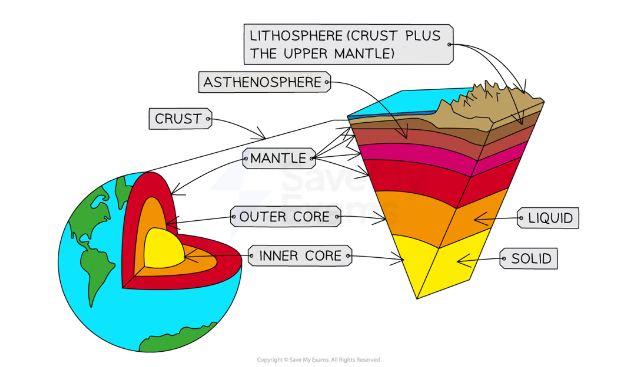
Describe the inner core:
solid ball of iron/nickel
under huge amount of pressure as it has the weight of the whole Earth pushing against it - causes it to remain solid
within it, radioactive elements like uranium & thorium are decaying - radioactive decay gives off lots of heat
over 5000°C - responsible for Earth’s internal energy - spreads throughout the different layers
about 1400km in diameter
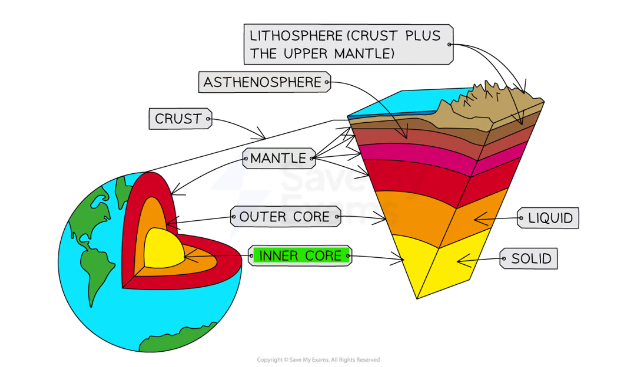
Describe the outer core:
molten (liquid) layer of iron & nickel - surrounds inner core
heat from inner core creates convection currents in outer core - transfers heat to mantle
about 2100km thick
temperatures between 4000 - 6000°C
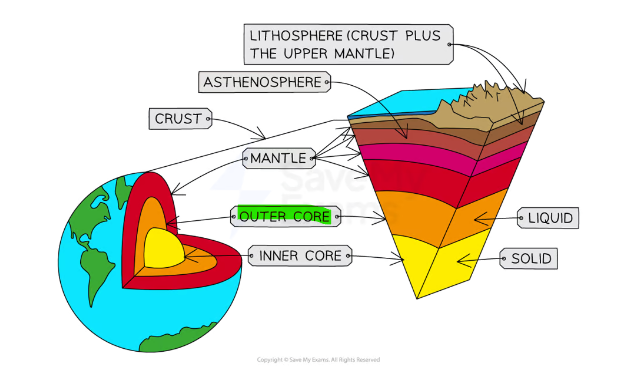
Describe the mantle:
largest layer of the Earth - about 2900km thick
semi-molten - mainly solid rock apart from very top, where it behaves like a very dense fluid
split into two parts - lower mantle & upper mantle
upper mantle has two layers - rigid upper layer(part of lithosphere) and the asthenosphere
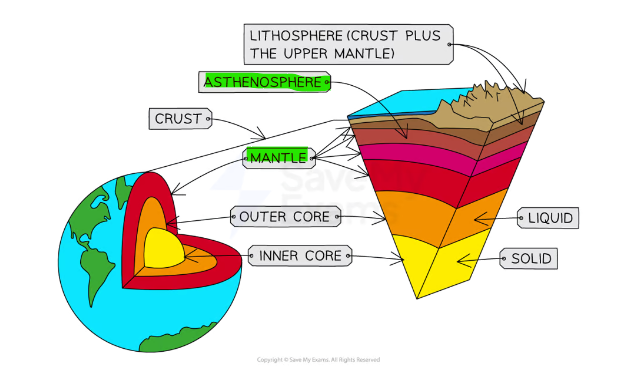
What is the asthenosphere?
The semi-molten top layer of the mantle which flows due to convection currents, moving the solid lithosphere above. Between 35-250km
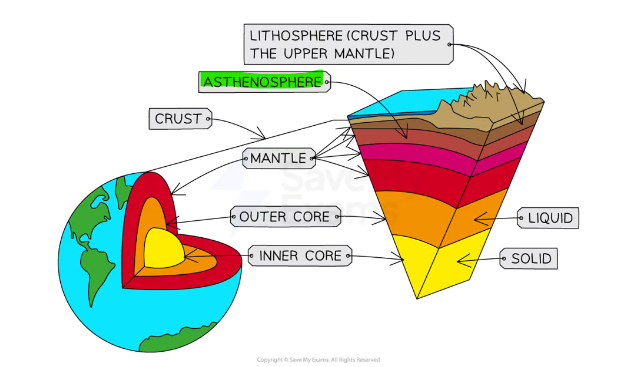
Describe the lithosphere:
solid rock layer that lies on top of asthenosphere
majority of lithosphere is technically in the mantle, very top is the Earth’s crust
crust is split into tectonic plates - range in thickness
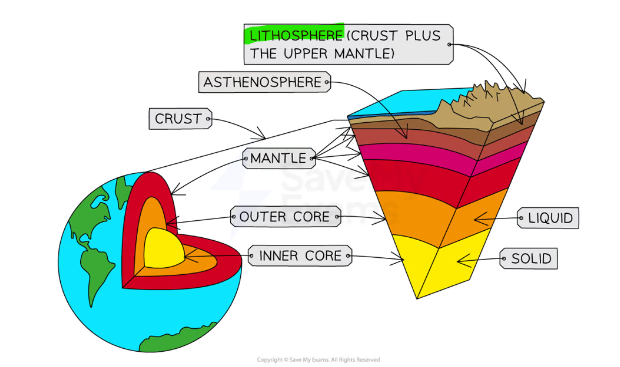
What are the two kinds of crust?
Oceanic crust
Continental crust
What is the oceanic crust?
The crust that makes up the ocean floor - younger (still very old), denser and thinner(5-10km). It is composed mainly of basalt.
What is the continental crust?
The crust that makes up our land - old, less dense & thick (25-100km). It is mainly composed of granite.
Why is oceanic crust continually being created and destroyed?
Because of plate movement where it is denser than the continental crust and therefore subducts under the continental crust.
What is the heat within the Earth generated by?
Radioactive decay.
What are tectonic plates?
Large slabs of the Earth’s crust that sit and move on top of the liquid mantle.
Describe how convection currents cause plate movement:
Energy from radioactive decay in the core heats up the fluid asthenosphere, this hot liquid is less dense than its surroundings, so it rises upwards. Upon reaching the top it cools and becomes more dense, therefore sinking back down to the bottom where it is heated up again, and the cycle continues. The plates, which lie on top, are pushed & pulled by the convection currents on the asthenosphere.
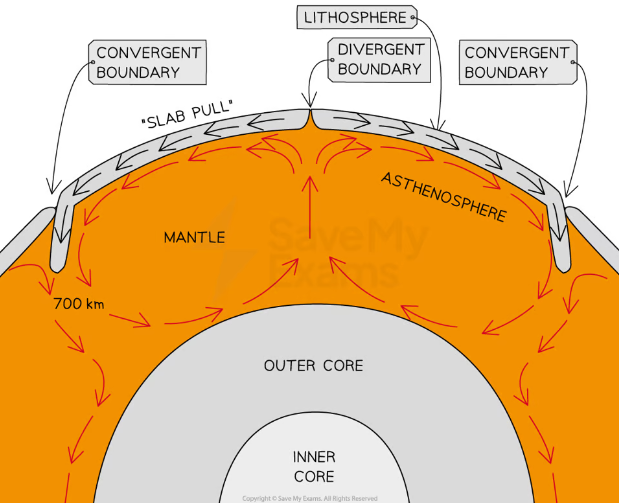
Describe the slab pull theory:
In addition to convection currents, plate movement is a result of the weight of denser oceanic plates subducting and dragging the rest of the plate along.
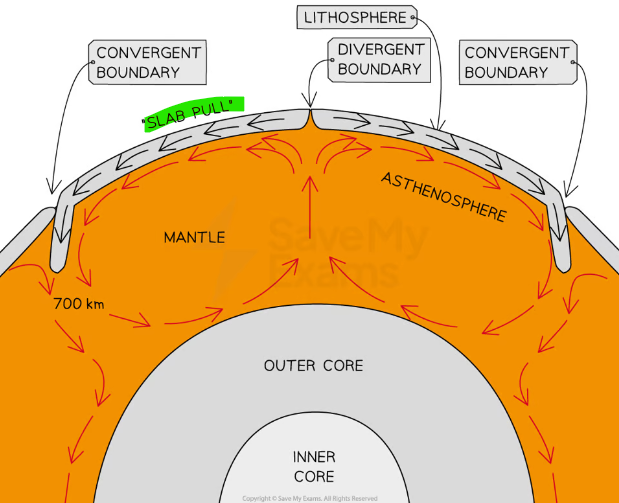
How many large tectonic plates is Earth’s crust broken into?
15
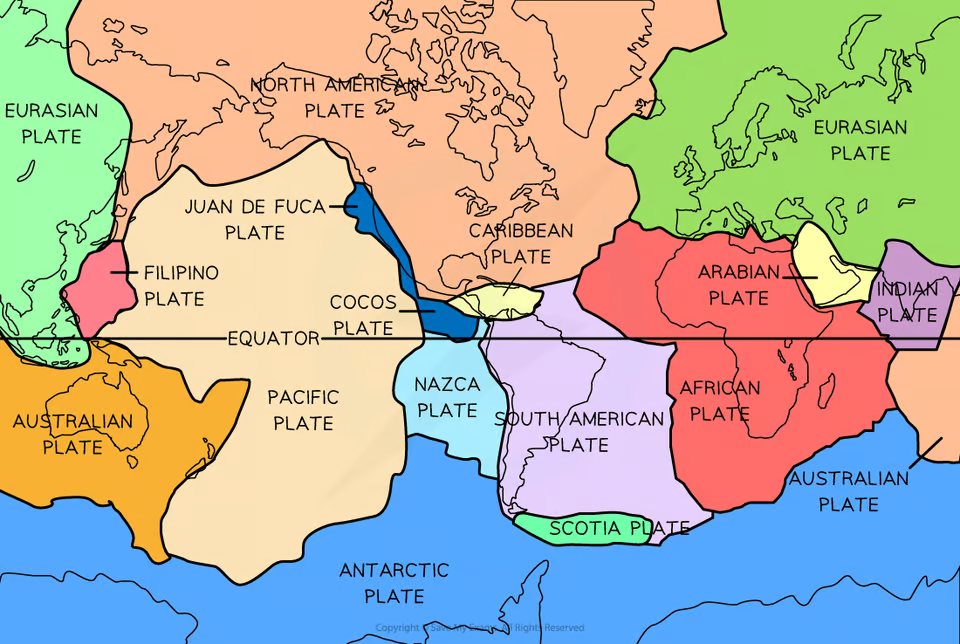
What plate is North America in?
North American plate.
What plate is Asia in?
Eurasian plate.
What is a plate boundary?
The point at which two plates meet.
What was Wegener’s theory of continental drift?
That all land masses were once one supercontinent called Pangaea that split off to form today’s continents.
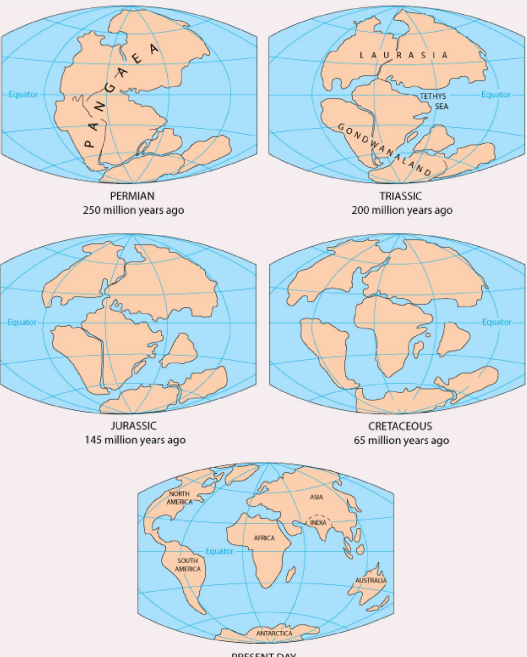
What was the evidence for Wegener’s theory?
The outlines of the continents fit together like a jigsaw. e.g. there is a match in shape between the east coast of South America & the west coast of Africa
There are similar patterns of rocks on both sides of the Atlantic
There are similar fossils on both sides of the Atlantic - including fossils of land animals that would have been unable to swim across from one side to the other
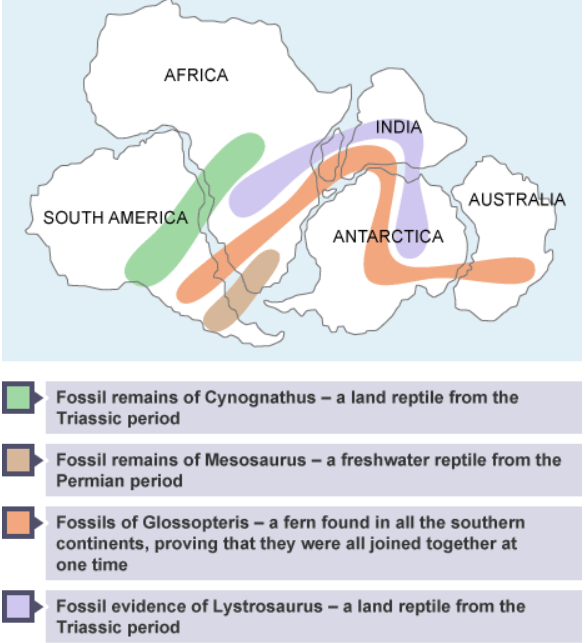
What are the three main type of plate boundaries?
Divergent
Convergent
Conservative
Divergent plate boundary movement:
Plates move away from each other.

Convergent plate boundary movement:
Plates move towards each other.
Conservative plate boundary movement:
Plates move alongside each other.
What is an earthquake?
The sudden, violent shaking of the ground as a result of pressure building when tectonic plates move.
What is the focus?
The point where the earthquake starts below the Earth’s surface - the energy released by the earthquake travels out from the focus.

What is the epicentre?
The point on the Earth’s surface directly above the focus.
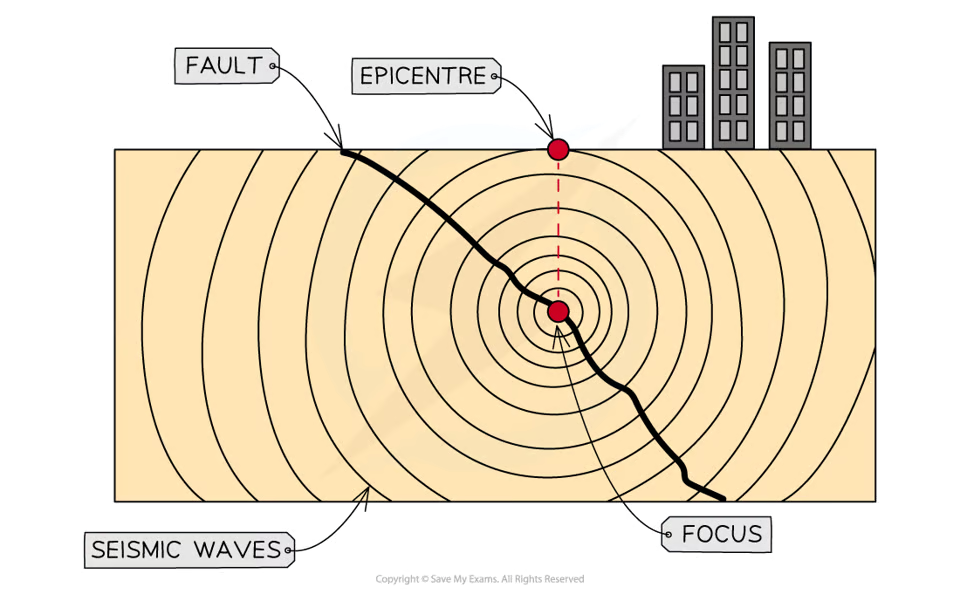
What scale is the magnitude of an earthquake measure on?
The Richter Scale.
How does the Richter Scale work?
The scale is logarithmic, which means that each number in the scale is 10x bigger than the last.
e.g. a 5.0 magnitude earthquake is 10x stronger/bigger than a 4.0 magnitude earthquake
What device is used to measure the magnitude of an earthquake?
Seismometer.
What scale is the damage caused by an earthquake measured on?
The Mercalli Scale.
What hazards can occur at divergent plate boundaries?
Volcanic eruptions and Earthquakes.
What happens at a divergent boundary to form hazards?
When the two plates are pulled apart, magma rises between the gap left by the two plates separating. Lava then pours out onto the surface - volcanoes form in the areas where lava pours out & the lava is usually runny & free-flowing creating flatter volcanoes. Earthquakes also occur here as plates shake & vibrate when plates move apart.
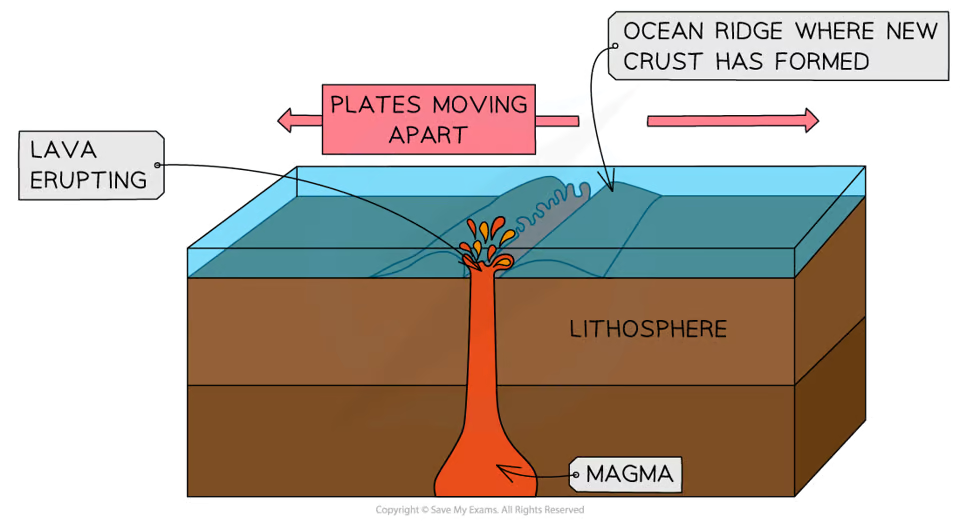
What is sea floor spreading?
When new land is formed on the ocean floor due to a divergent plate boundary on oceanic crust. Causes the floor to spread and get wider.

What do divergent plate boundaries cause on continental crust?
They cause huge fractures in the land, creating lowland regions called rift valleys.
e.g. the East African Rift
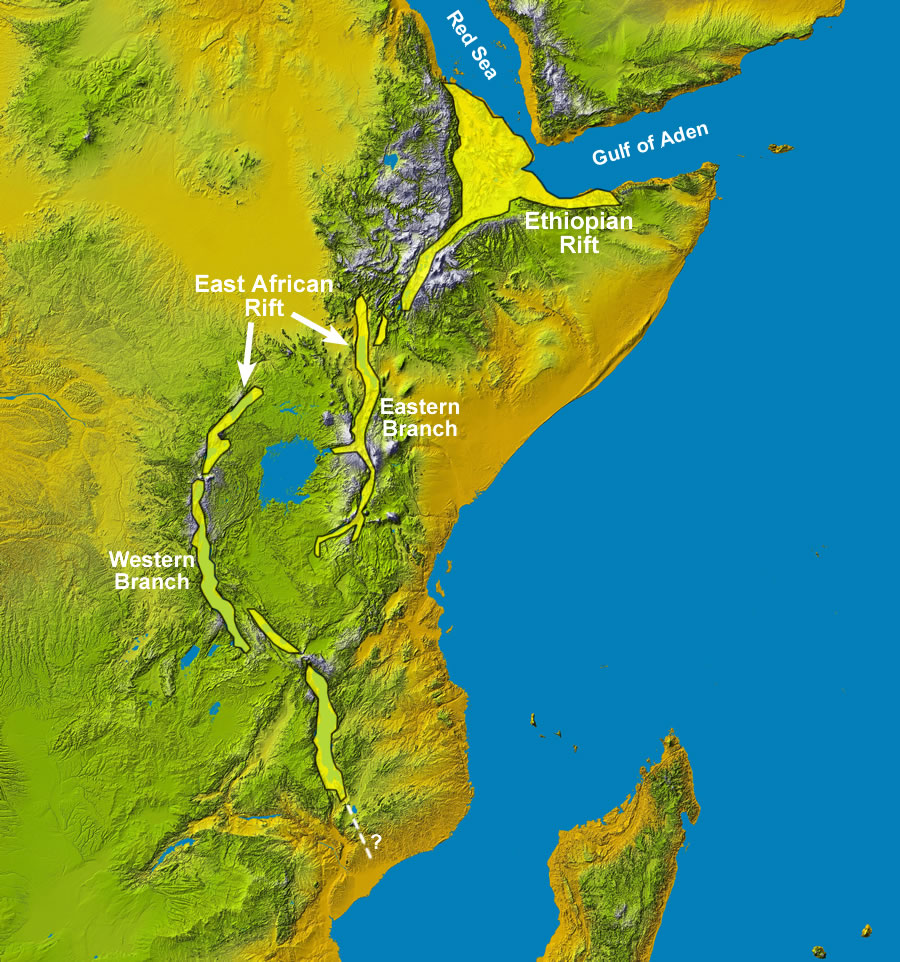
What is an example of a divergent plate boundary?
The Mid Atlantic Ridge.
What hazards can occur at convergent plate boundaries?
Strong, deep earthquakes and explosive volcanoes.
What happens at a convergent boundary to form hazards?
The plates move towards each other and the denser oceanic crust is subducted below the continental crust. The plate that is subducting leaves a deep ocean trench. Friction between the two plates causes strong & deep earthquakes. The oceanic crust is melted as it is pulled deeper into the mantle, creating magma. This magma causes pressure to build up under the crust and eventually the magma pushes out through weaknesses in the crust - creating explosive volcanoes.
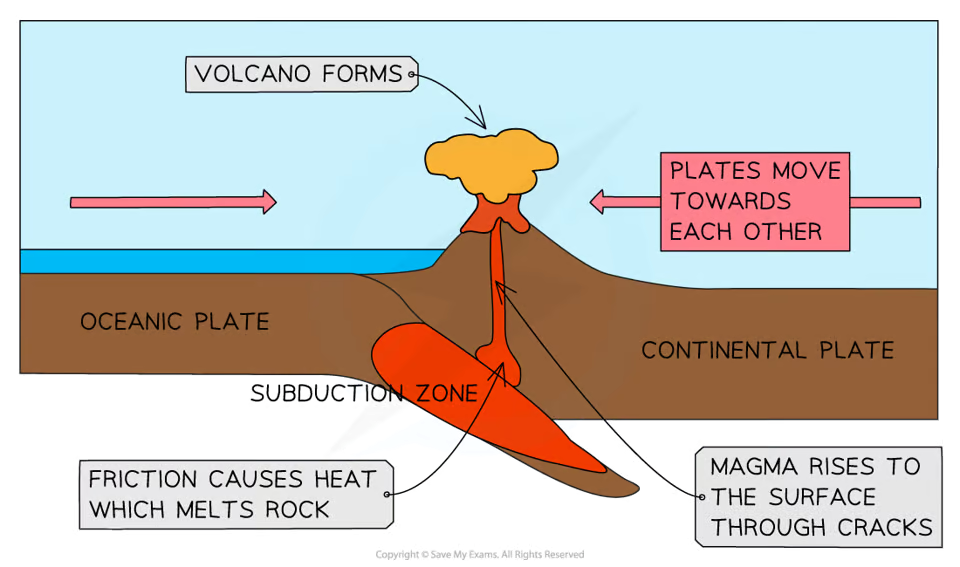
What happens when two oceanic plates converge?
The denser plate sinks below and islands in the ocean can form. e.g. Mariana trench.
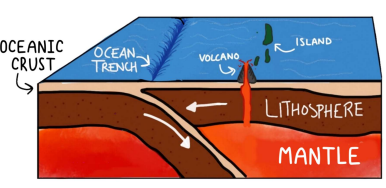
What happens when two continental plates converge?
Forms a collision zone where neither plate can subduct below the other. Instead the crust is crumpled upwards by the pressure building between two plates, creating fold mountains.

What is an example of a collision zone?
Where the Eurasian and Indian plate meet to form the Himalayas.
What hazards can occur at conservative plate boundaries?
Earthquakes.
What happens at a conservative boundary to form earthquakes?
At a conservative boundary, parallel plates move in different directions/at different speeds in relation to each other. When these plates move side by side, friction builds between the plates. This friction builds up over many years and eventually the pressure becomes so large that the plates eventually move in a sudden jolt. This releases a lot of energy which sends vibrations through the ground - this is the earthquake.

What is an example of a conservative plate boundary?
The San Andreas Fault in California.
What can conservative boundaries on oceanic crust cause?
The movement of earthquakes formed at conservative boundaries can displace a lot of water, causing large waves called tsunamis.
What can conservative boundaries on continental crust cause?
On continental crust, fault lines can occur where the ground is cracked by the movement.
What are hotspots?
Areas of volcanic activity where unusually hot magma breaks through the middle of a plate and travels up to the surface, creating a volcano. They are not related to plate boundaries
How do hotspots form?
Formed when hot magma plumes from the mantle rise and burn through weaker parts of the crust. This can create volcanoes and islands.
How do long chains of islands form?
Long chains of islands form because the plume stays in the same place but the plates continue to move slowly over the magma plume.
e.g. Hawaii

When is a volcano formed?
When magma erupts onto the Earth’s surface as lava through a vent in the Earth’s crust.
What is the magnitude of a volcanic eruption measured on?
The Volcanic Explosivity Index (VEI).
Features of a volcano:
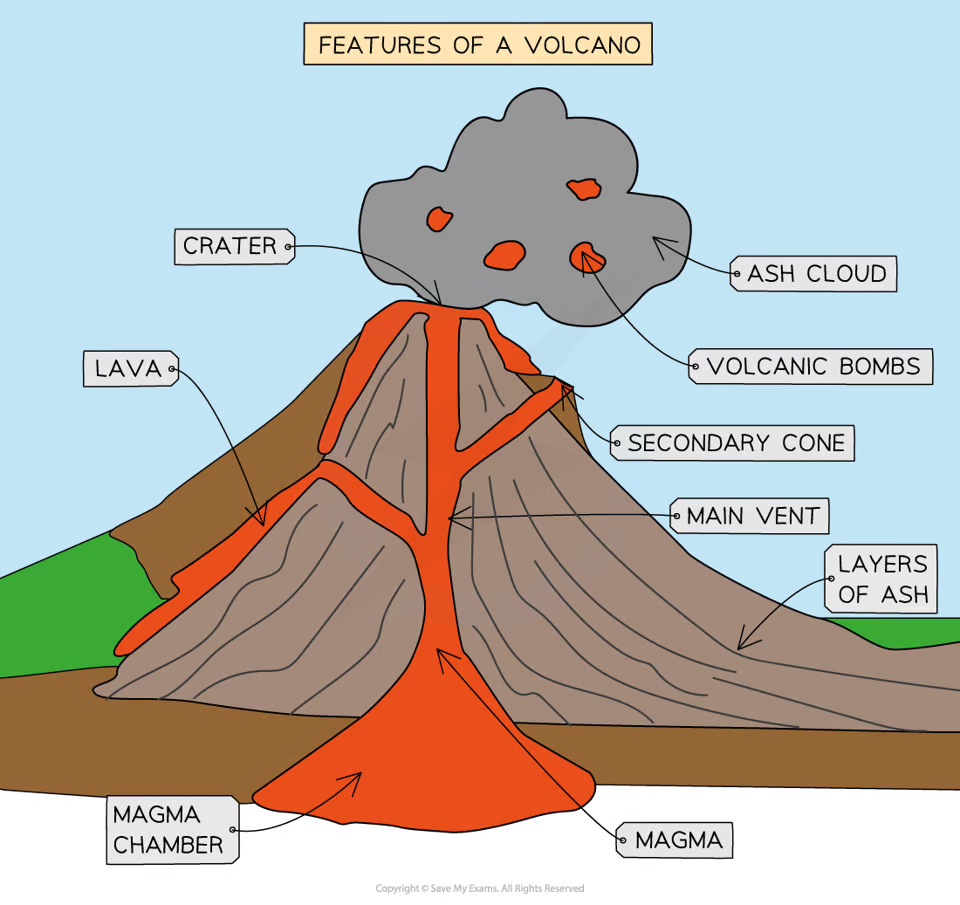
What are the characteristics of a composite volcano?
Steep-sided due to slow-moving lava
Sticky, viscous lava
More explosive - due to higher gas content
Formed from alternating layers of ash & lava
Tend to form on convergent plate boundaries
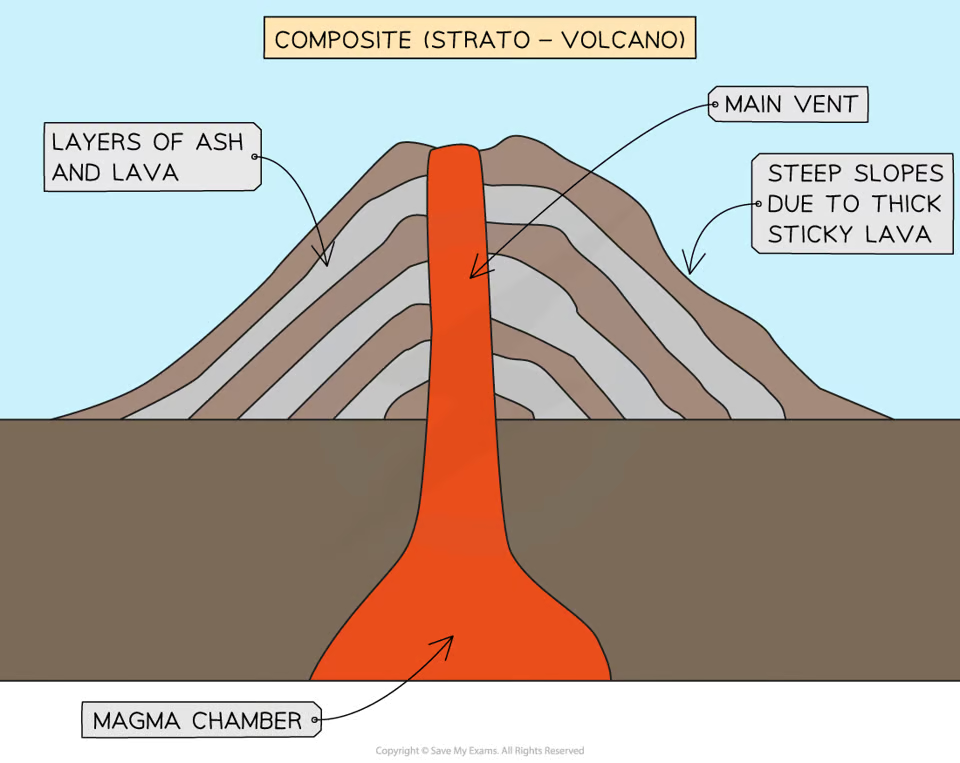
What are the characteristics of a shield volcano?
Gentle sloping sides due to fast-moving, runny lava that travels a further distance before solidifying
low viscosity (runny), thin lava
Less explosive - due to lower gas content - gentle eruptions
Tend to form on divergent plate boundaries or hot spots
Frequent eruptions
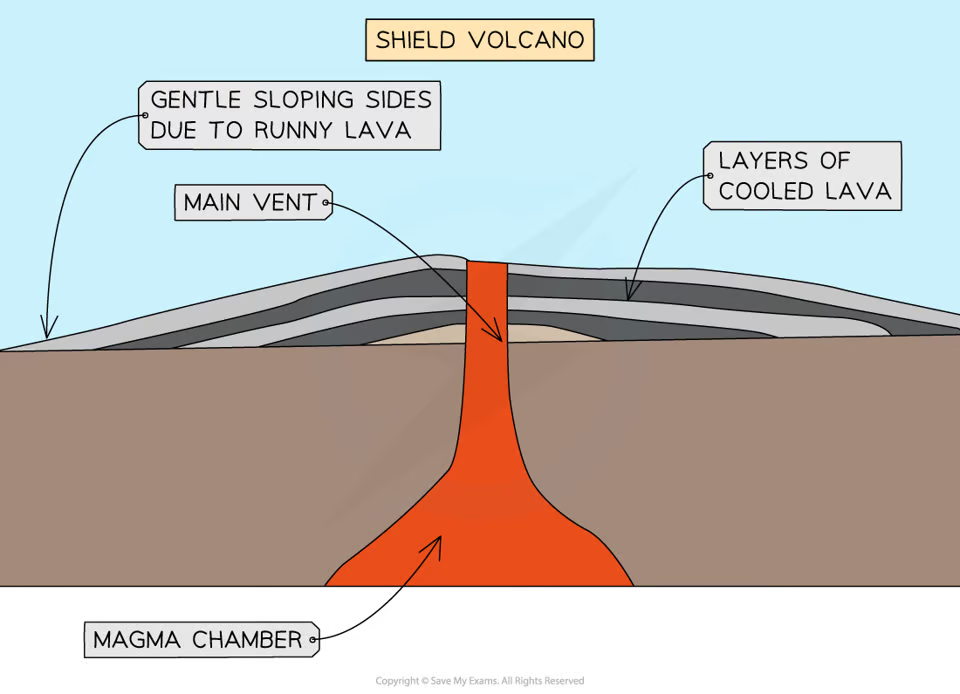
Active volcano:
The volcano has recently erupted & is likely to erupt again.
Dormant volcano:
Has erupted in the last 2000 years and may possibly erupt again.
Extinct volcano:
Shows no evidence of eruption in historic times & there is no evidence of a magma reservoir.
Explain one difference between the type of volcanoes found at divergent and convergent plate boundaries.
(3 Marks)
At divergent boundaries the volcanoes are less steep because of the low viscosity/runny lava that travels a greater distance before it solidifies.
What is pyroclastic flow?
Fast-moving, very hot clouds of poisonous gases mixed with ash. Average speeds of about 100km/h - can move at up to 700km/h.
What are lahars?
When volcanoes erupt, snow & ice on the peak melts & combines with the ash/pyroclastic material. This creates fast moving mudflows called lahars.
Describe volcanic eruptions at divergent plate boundaries and the kind of volcanoes they form:
Eruptions are non-explosive with runny, fast-flowing lava
The lava is made up of basalt - very hot and low viscosity
Low viscosity lava creates shallow sided (flat) shield volcanoes.
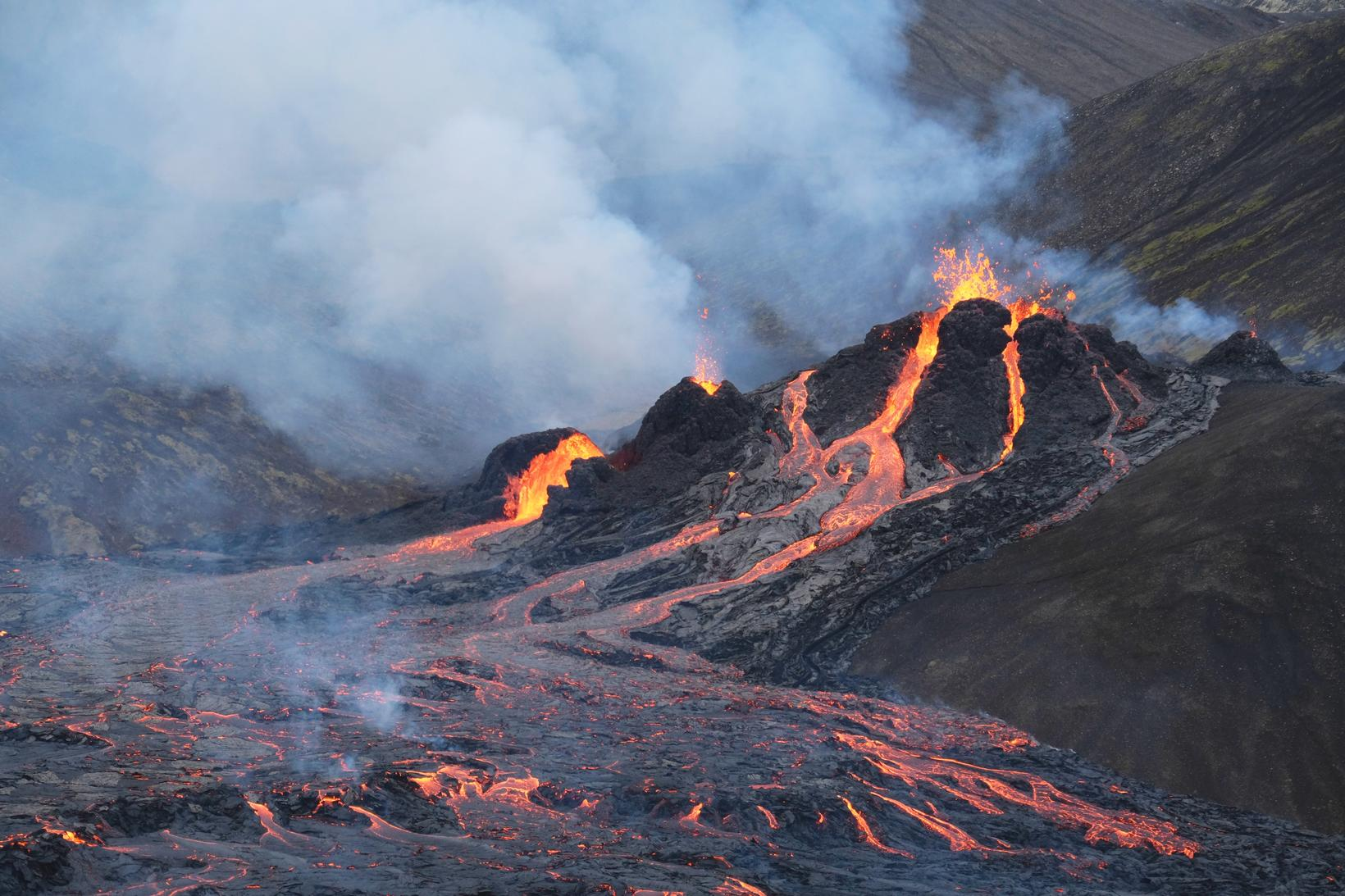
Describe volcanic eruptions at convergent plate boundaries and the kind of volcanoes they form:
Eruptions are usually explosive due to the high pressure the magma is under
Hot gas, ash & rock is spewed from the volcano due to high pressure
Fast, extremely hot clouds of gas, ash & debris can roll down the side of the volcano in a pyroclastic flow - can incinerate anything in its path
Lava is made of andesite - causes lava to be viscous & slow flowing
Steep sided composite volcanoes are formed
Describe earthquakes on conservative boundaries:
Very destructive & intense - up to 8.5 magnitude
If an earthquake is shallow (close to surface) the earthquake can cause very intense shaking - can bring down buildings, break pipes & destroy infrastructure
Describe earthquakes on convergent boundaries:
Very strong earthquakes due to pressure built up and then released between subducting plates - up to 9.5+ magnitude
Can be very severe especially if shallow - however are usually deep as the plate is sinking
Describe earthquakes on divergent boundaries:
Usually smaller & cause less damage as there is less built up pressure at these boundaries
5.0-6.0 on the Richter Scale
Where do most earthquakes occur?
Along the Pacific ‘Ring of Fire’. Around 90% occur there.
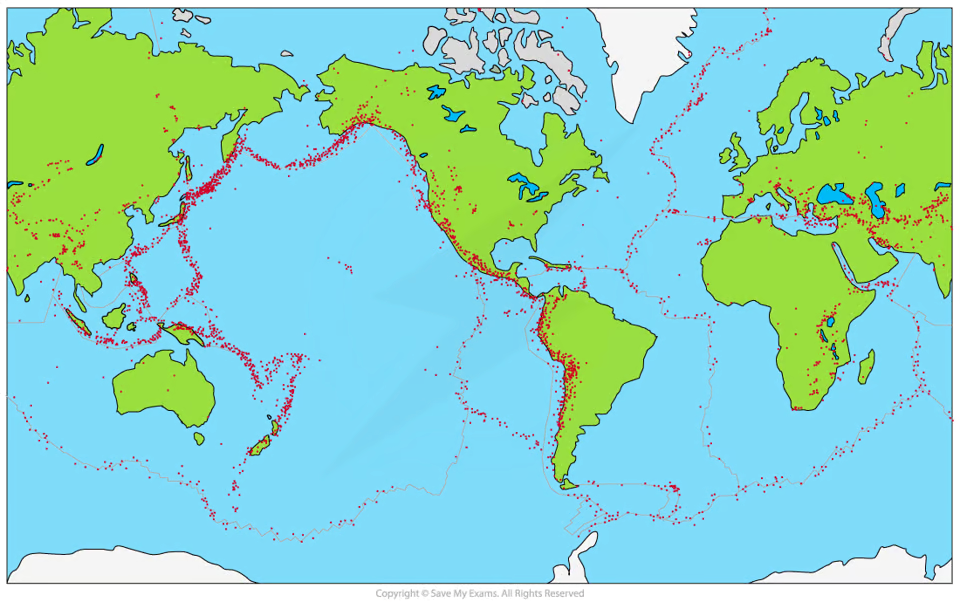
Where do most volcanoes occur?
Around the rim of the Pacific Ocean called the ‘Ring of Fire’. Around 75% occur there.
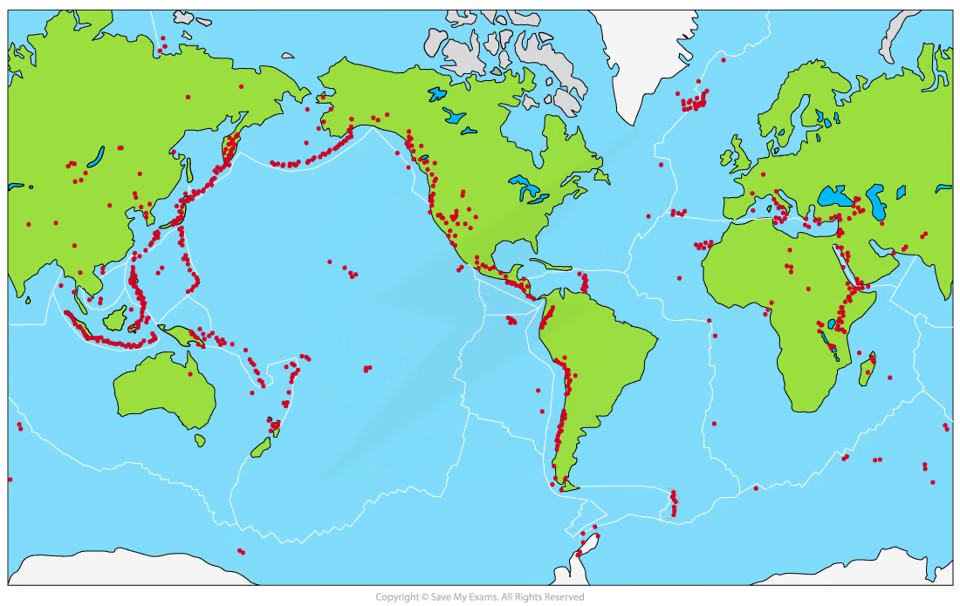
At what plate boundaries do earthquakes tend to be stronger?
Convergent & conservative plate boundaries.
How do you strengthen a building against earthquakes?
Installing a ring beam at roof level stopping walls falling outwards.
Very strong framework in skyscrapers.
Rubber and steel foundations which can move slightly.
Deeper foundations.
Reinforcing gas and water pipes so they don't break.
The impacts of earthquakes and volcanic eruptions are categorised into…
Primary hazards - direct result of the earthquake or eruption
Secondary hazards - occur as a result of the primary effects
What are some primary hazards of an earthquake?
Ground shaking
Surface rupture
What are some secondary hazards of an earthquake?
Liquefaction - when loose material like soil & rocks act like a liquid
Landslides
Tsunamis
Fires
What are some primary hazards of a volcanic eruption?
Pyroclastic flow
Lava flow
Volcanic bombs
Lahars (mudflow)
Earthquakes
Direct ash fall
What is pyroclastic flow?
Fast-moving, hot mixture of gas, ash, and volcanic debris that erupts from a volcano during an explosive eruption
What are some secondary hazards of a volcanic eruption?
Landslides
Tsunamis
Acid rain
Ash fallout from the atmosphere
What is a tsunami?
A large wave caused by a large amount of water being displaced when plates move.
Describe how a tsunami can form:
When an oceanic crust is jolted during an earthquake, all of the water above this plate is displaced
The water travels fast but with a low amplitude (height)
As it gets closer to the coast, the sea level decreases so there is friction between the sea bed and the waves
This causes the wave to slow down and the wavelength becomes compressed, which leads to an increase in height - creating a wall of water that can reach 5-10 meters
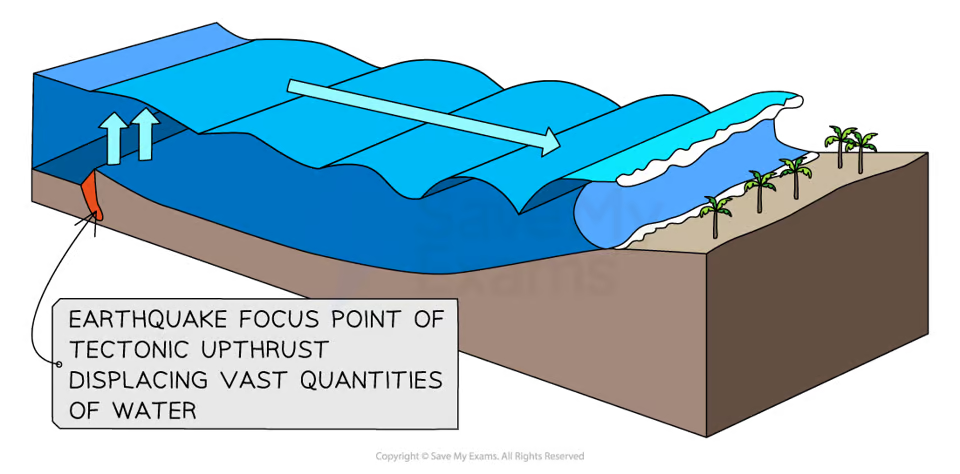
Impacts of earthquakes and volcanic eruptions:
Loss of life & injury - may be immediate through falling buildings/ash fall or days and weeks after the event due to unclean water or disease
Collapse or destruction of buildings - leads to people being homeless for months & even years after the event
Transport network - roads, bridges and railways may be damaged or destroyed - can impact speed aid can reach affected areas
Loss of jobs and businesses - impacts the economy when factories & offices are destroyed or damaged
Loss of crops - leads to food shortages & affects farmers income
Power and water supplies are damaged - affects the supply of potable water
Damage to the environment - loss of vegetation & habitats, ash affects climate
Closure of airports - dangerous for jet planes to fly through ash clouds due to possible engine failure - flights are cancelled